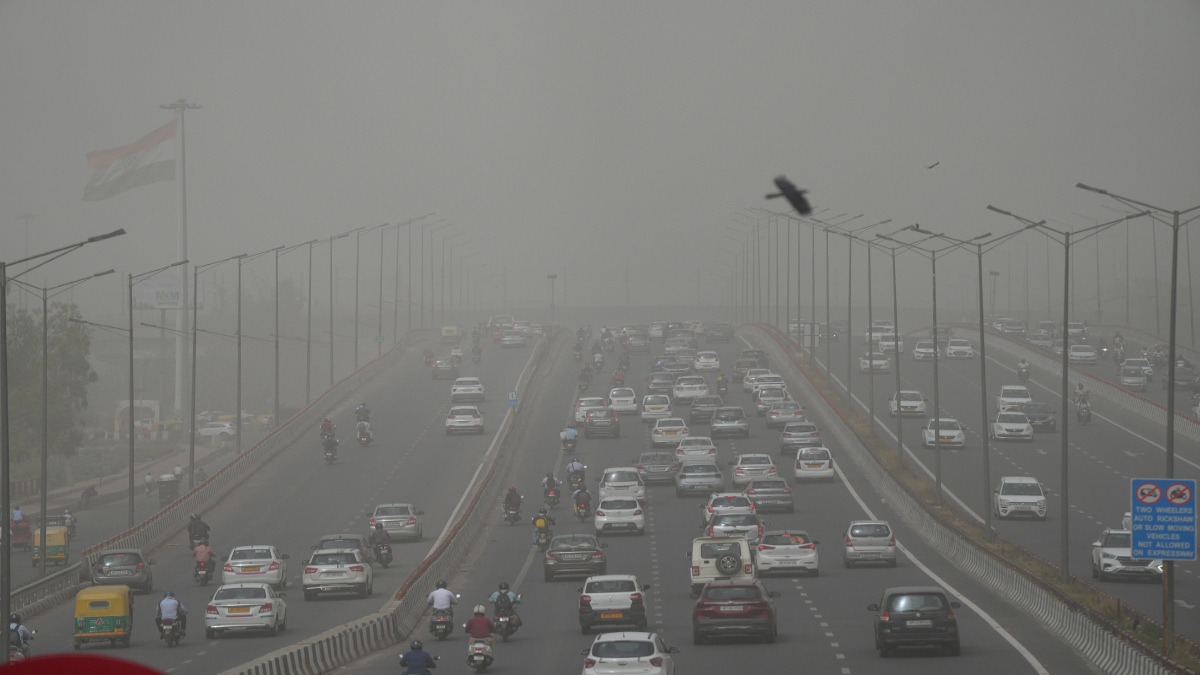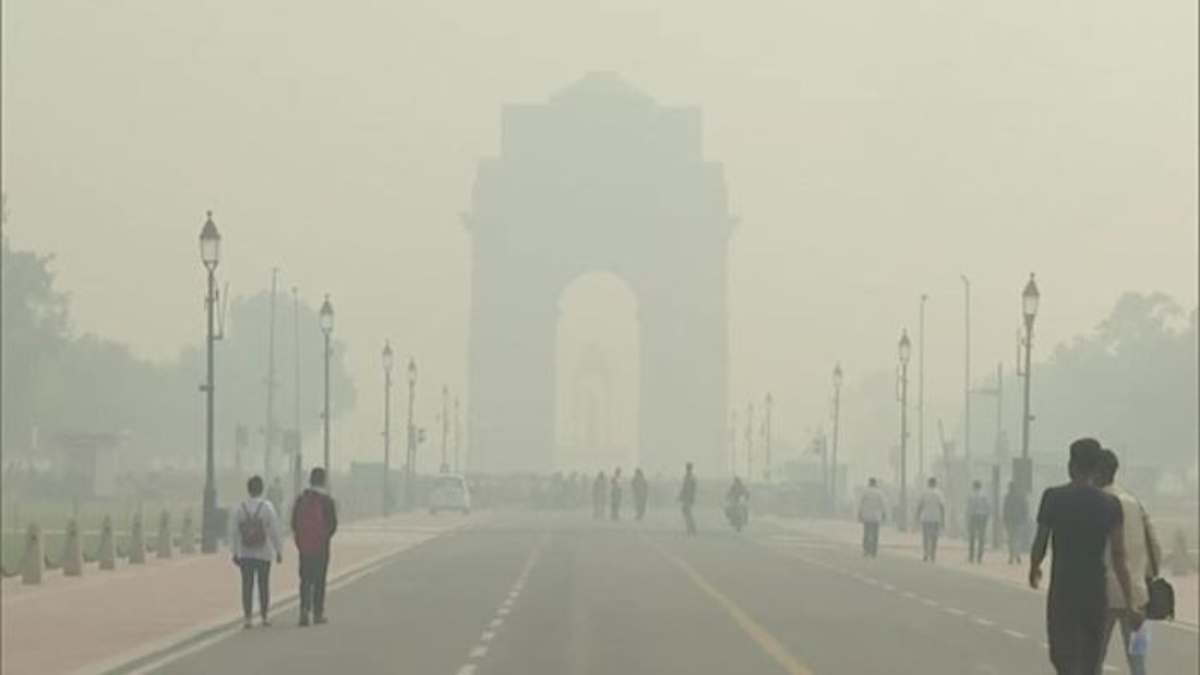Delhi grapples with ‘severe’ air quality as AQI soars to 404 today
Delhi grapples with ‘severe’ air quality as AQI soars to 404 today
On a recent Saturday morning, Delhi witnessed a precipitous drop in air quality, plunging into the ‘severe’ category, according to reports from the System of Air Quality and Weather Forecasting And Research (SAFAR-India). The escalation in air pollution levels underscored the ongoing environmental challenges faced by the capital city.
The swift deterioration in air quality, reaching the ‘severe’ category, is a cause for heightened concern regarding public health and environmental well-being. Such severe levels of air pollution can have deleterious effects on respiratory health and exacerbate existing respiratory conditions, posing a significant risk to the general populace.
Delhi, known for its struggles with air pollution, experiences seasonal variations that often lead to spikes in particulate matter concentrations. Factors such as vehicular emissions, industrial activities, and adverse meteorological conditions can contribute to the escalation of air pollution levels. The ‘severe’ categorization indicates that the air quality poses a severe risk to health and necessitates immediate attention and remedial measures.
SAFAR-India’s monitoring and reporting play a crucial role in keeping the public informed about the environmental conditions. The severity of the situation prompts a call to action for authorities to implement measures aimed at mitigating the impact of air pollution. This may include stricter regulations on industrial emissions, traffic management initiatives, and public awareness campaigns to encourage responsible environmental practices.
The incident serves as a reminder of the need for sustained efforts to address the root causes of air pollution in Delhi. Long-term solutions may involve a comprehensive approach, including transitioning to cleaner energy sources, improving public transportation, and implementing stringent regulations to control emissions from various sources.
The impact of poor air quality on public health emphasizes the urgency of adopting sustainable practices and policies to safeguard the well-being of residents. It also underscores the interconnectedness of environmental health and human health, reinforcing the importance of a concerted effort by both government and citizens to address and rectify the environmental challenges faced by the city.
As of 9 am, the Air Quality Index (AQI) for Delhi NCR surged to 404, indicative of the severe levels of air pollution in the region. This escalation in pollution levels raises significant concerns for public health and underscores the persistent challenges faced by the capital city in maintaining breathable air.
The specific breakdown of pollution levels in different areas within Delhi revealed varying degrees of air quality deterioration. In the Pusa area, the AQI was recorded at 395, while IIT Delhi reported a slightly lower but still alarming AQI of 385. These localized variations highlight the spatial complexity of air pollution, with certain areas experiencing higher concentrations of pollutants due to specific local factors.
The overall AQI reaching 404 is a cause for immediate attention and underscores the severity of the air pollution crisis in the region. An AQI in the ‘severe’ category signifies a critical level of pollution that poses substantial risks to public health, especially for individuals with respiratory conditions and vulnerable populations.
The factors contributing to this deterioration in air quality are multifaceted and may include vehicular emissions, industrial activities, and adverse meteorological conditions that trap pollutants in the atmosphere. Such conditions demand swift and decisive actions to address the root causes of air pollution and implement short-term measures to alleviate the immediate impact on public health.
Efforts to combat air pollution in Delhi may involve stringent regulatory measures, such as controlling industrial emissions, enforcing vehicular emission standards, and implementing traffic management strategies. Additionally, public awareness campaigns and initiatives to promote cleaner and sustainable practices can contribute to long-term solutions.
The real-time monitoring and reporting of AQI by organizations like SAFAR-India play a crucial role in keeping the public informed about the environmental conditions and urging authorities to take prompt action. The situation in Delhi reinforces the pressing need for comprehensive and sustained efforts to tackle air pollution and create a healthier and more sustainable living environment for residents.
As air quality in Delhi deteriorated, specific locations witnessed alarming levels of pollution, as reported by the System of Air Quality and Weather Forecasting And Research (SAFAR-India). Lodhi Road recorded an Air Quality Index (AQI) of 378, categorizing it as ‘very poor,’ indicating a notable decline in air quality but not yet reaching the ‘severe’ range.
However, the situation was more severe in other areas. Delhi University faced heightened pollution levels with an AQI soaring to 416, pushing it into the ‘severe’ category. This classification underscores the immediate health risks posed by the poor air quality in the university vicinity, demanding urgent attention and mitigation measures.
The air quality at the Delhi IGI Airport Terminal 3 reached a critical level, registering an AQI of 432. This signifies an exceptionally high concentration of pollutants in the air, emphasizing the severity of the pollution crisis at one of the city’s vital transport hubs. Such critical levels of pollution pose substantial health hazards, especially for individuals with respiratory conditions and those vulnerable to the adverse effects of poor air quality.
The diverse AQI readings across these locations highlight the localized variations in pollution levels within the city. Factors such as traffic density, industrial activities, and geographical features can contribute to the spatial complexity of air pollution, necessitating targeted interventions in specific areas.
SAFAR-India’s monitoring and reporting serve as a crucial tool for both authorities and the public to gauge the severity of air quality conditions. The real-time data not only raises awareness about the existing pollution levels but also prompts the implementation of immediate measures to mitigate the impact on public health.
The situation underscores the multifaceted nature of the air pollution challenge in Delhi, requiring a comprehensive approach to address the root causes. Regulatory measures, such as controlling emissions from industries and enforcing vehicular emission standards, coupled with public awareness campaigns, are essential components of a strategy aimed at improving air quality in the long term.
As Delhi grapples with this urgent environmental issue, a concerted effort involving government initiatives, community participation, and sustainable practices is imperative to safeguard the health and well-being of the residents and mitigate the adverse effects of air pollution.
The air quality crisis extends beyond Delhi, with neighboring cities grappling with deteriorating conditions. On Saturday, Ghaziabad recorded an alarming Air Quality Index (AQI) of 424, categorizing it as ‘severe.’ Gurugram faced ‘very poor’ air quality with an AQI of 345, while Greater Noida and Noida experienced ‘very poor’ conditions with AQI readings of 398 and 393, respectively. Faridabad, too, reported a concerning AQI of 426, placing it in the ‘severe’ category. This widespread degradation of air quality in the National Capital Region (NCR) raises serious health concerns for residents.
In response to the challenging environmental conditions, there is a glimmer of hope on the horizon. A scientist from the India Meteorological Department (IMD) indicated a forecast for temporary relief in meteorological conditions in northwest India. This respite is anticipated due to the influence of an approaching western disturbance, expected to commence from Sunday. The potential improvement in meteorological conditions could aid in mitigating the adverse effects of air pollution, offering a reprieve to residents and authorities grappling with the ongoing crisis.
The observed rise in AQI levels in Delhi over recent days follows a brief period of improvement noted last Sunday. This fluctuation underscores the dynamic nature of the air quality situation and emphasizes the need for sustained efforts to address the underlying causes of pollution in the region.
As the authorities work towards implementing measures to combat air pollution, the upcoming changes in meteorological conditions offer a temporary but crucial opportunity to alleviate the severity of the situation. Long-term solutions, including regulatory measures and public awareness campaigns, remain essential to address the root causes and establish a sustainable path toward better air quality in the region.
The collaboration of various stakeholders, including government bodies, communities, and environmental organizations, is imperative to bring about meaningful change and safeguard the health and well-being of the residents in Delhi and its neighboring cities.
In Kanpur, a significant revelation points to biomass burning as the predominant factor contributing to Delhi’s poor air quality, comprising a substantial 51 percent of the capital’s air pollution on Friday. This finding sheds light on a critical source of environmental degradation, emphasizing the need for targeted interventions to address this specific aspect of pollution.
According to data, vehicular emissions accounted for approximately 31 percent of the overall air pollution in Delhi on the preceding day. This highlights the multifaceted nature of the air quality challenge, with both biomass burning and vehicular emissions playing significant roles in exacerbating pollution levels in the city.
In response to these concerning findings, Delhi’s Environment Minister, Gopal Rai, has taken proactive measures. He has instructed relevant agencies and departments to rigorously enforce restrictions on polluting vehicles. Additionally, the minister has directed efforts toward addressing the escalating incidents of biomass burning, recognizing the urgent need to curb this practice.
The emphasis on enforcing restrictions on polluting vehicles aligns with broader strategies to reduce vehicular emissions, a major contributor to air pollution in urban areas. Implementing and strengthening regulations, promoting the use of cleaner technologies, and encouraging public transportation are crucial components of mitigating the impact of vehicular emissions on air quality.
Addressing biomass burning is equally imperative, considering its significant share in Delhi’s air pollution. This may involve stringent enforcement of bans on crop residue burning, promoting alternative agricultural practices, and raising awareness among farmers about the environmental consequences of this activity.
The minister’s directives underscore a proactive approach to tackle the root causes of air pollution in Delhi. By targeting specific sources such as biomass burning and vehicular emissions, authorities aim to create a more sustainable and breathable environment for the residents of the city. The success of these efforts relies on coordinated action, public cooperation, and the continuous commitment of all stakeholders involved in improving air quality.
Gopal Rai, Delhi’s Environment Minister, has acknowledged a notable rise in pollution levels in the city and has addressed the concerning factors contributing to this increase. In response to this environmental challenge, he shared insights from a recent meeting and outlined the primary contributors to Delhi’s escalating pollution levels.
During the meeting, it was reported that stubble burning, a significant source of pollution in the past, has reduced considerably, yet pollution levels persist in rising. Scientists identified 2-3 key factors contributing to this trend. Firstly, vehicle pollution was identified as a major contributor, accounting for 36% of the overall pollution. The second significant factor was biomass burning, emphasizing the impact of this practice on the air quality in the region.
In light of these findings, Gopal Rai announced decisive measures to address the identified factors. To curb vehicle pollution, the government has implemented rules outlined in the Graded Response Action Plan (GRAP) Phase 3. The GRAP is a comprehensive strategy that involves graded measures to combat air pollution in the Delhi-NCR region. By taking specific actions to control vehicular emissions, the government aims to mitigate one of the key contributors to the pollution crisis.
The acknowledgment of the reduction in stubble burning incidents reflects the success of initiatives aimed at curbing this agricultural practice. However, the persistence of rising pollution levels underscores the complexity of the challenge and the need for a multifaceted approach to tackle various sources of pollution, including vehicular emissions and biomass burning.
Gopal Rai’s proactive stance, as reflected in the decisions made following the meeting, highlights the commitment of authorities to address the root causes of air pollution in Delhi. The effective implementation of rules, alongside sustained efforts to reduce emissions from various sources, remains crucial for achieving a significant and lasting improvement in the air quality of the region.




